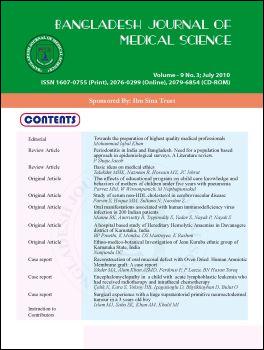A hospital based study of Hereditary Hemolytic Anaemias in Davanagere district of Karnataka, India
DOI:
https://doi.org/10.3329/bjms.v9i3.6471Keywords:
hereditary hemolytic anaemia, clinoco-hematological study, hemoglobin electrophoresisAbstract
Background: Hereditary hemolytic anaemias constitute important cause of mortality and morbidity in developing countries next only to infection and malnutrition.These group of anaemias have various clinical presentations starting from their age of onset of symptoms, failure to thrive, anaemia, prostration, jaundice, splenomegaly, cholelithiasis, cardiomegaly, congestive cardiac failure, severe life threatening infections and chronic disabilities leading to distress in the families.Methodology: An analysis of 40 cases of hereditary hemolytic anaemia in the age group of 2 months to 12 years was done in the present study. On the basis of clinical presentations, physical findings, routine hematological investigations and hemoglobin electrophoresis pattern in hemoglobin defects were carried out to identify the type of hemolytic anaemias.
Results: This clinocohematological study of hereditary hemolytic anaemia showed membrane defects- Hereditary spherocytosis in 4 cases (10%). The remaining 36 cases were having diseases affecting hemoglobin molecule which included Sickle cell anaemia-5 cases (12.5%), Sickle cell trait- 1 case (2.5%), Sickle cell/β thalassemia-1 case (2.5%), β thalassemia major- 23 cases (57.5%) and β thalassemia trait 6 cases(15%). Hereditary hemolytic anaemia with enzyme defects were not observed in this study. Majority of these cases presented with progressive pallor and hepatosplenomegaly. Peripheral blood smear examination showed microcytic hypochromic anaemia (87.5%) in majority of the cases. All cases were associated with reticulocytosis. Hemoglobin electrophoresis confirmed the diagnosis.
Conclusion: Inspite of advanced diagnostic inestigations, the basic hematological investigation remains first panel or step towards the approach to diagnose hereditary hemolytic anaemia and hemoglobin electrophoresis will help in confirming the diagnosis.
Keywords: hereditary hemolytic anaemia; clinoco-hematological study; hemoglobin electrophoresis
DOI: 10.3329/bjms.v9i3.6471
Bangladesh Journal of Medical Science Vol.09 No.3 July 2010, pp.154-160
Downloads
Download data is not yet available.
Abstract
278
278
PDF
348
348
Downloads
How to Cite
Preethi, B., Monika, K., Maitreyee, D., & Rashmi, K. (2010). A hospital based study of Hereditary Hemolytic Anaemias in Davanagere district of Karnataka, India. Bangladesh Journal of Medical Science, 9(3), 154–160. https://doi.org/10.3329/bjms.v9i3.6471
Issue
Section
Original Articles
License
Authors who publish in the Bangladesh Journal of Medical Science agree to the following terms that:
- Authors retain copyright and grant Bangladesh Journal of Medical Science the right of first publication of the work.

Articles in Bangladesh Journal of Medical Science are licensed under a Creative Commons Attribution 4.0 International License CC BY-4.0.This license permits use, distribution and reproduction in any medium, provided the original work is properly cited.- Authors are able to enter into separate, additional contractual arrangements for the distribution of the journal's published version of the work (e.g., post it to an institutional repository or publish it in a book), with an acknowledgement of its initial publication in this journal.
- Authors are permitted to post their work online (e.g., in institutional repositories or on their website) as it can lead to productive exchanges, as well as greater citation of published work.




